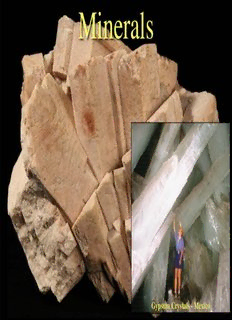
Minerals - Appalachian State University PDF
Preview Minerals - Appalachian State University
Minerals Gypsum Crystals - Mexico Rocks • Rocks are Earth materials made from minerals. • Most rocks have more than one kind of mineral. – Example: Granite • Potassium feldspar. • Plagioclase Feldspar. • Quartz. • Hornblende. • Biotite • Some are monomineralic. – Limestone (Calcite). – Rock salt (Halite). – Glacial ice. Minerals • If geology was a language: Minerals = Letters of the Alphabet Rocks = Words • So, in order to understand the language of geology, one must be able to properly identify the letters of the language. Malachite crystals – copper carbonate • Mineralogy – The study of minerals • Mineralogist – Someone who studies minerals, their composition, uses, and properties Galena crystals – lead sulfate What is a Mineral? What is a mineral? Definition: a 1homogeneous, 2naturally-occurring, 3solid, and 4 generally inorganic substance with a 5definable chemical composition and an 6orderly internal arrangement of atoms Six parts to the definition – each is important and necessary Does not include “minerals” in the nutritional sense • Your text covers some basic chemistry terms that I will assume that you already know. If you need a refresher, read pages 46-49 in your text and refer to Appendix 3. This material is fair game on a exam. • e.g. atom, molecule, element, cation, anion, electron, proton, neutron, covalent bond, ionic bond, atomic number, atomic mass, isotopes, etc… 1- Homogeneous • Definition: Something that is the same through and through – Cannot be broken into simpler components 2- Naturally Occurring • Minerals are the result of natural geological processes – Man-made minerals are called synthetic minerals (e.g. industrial diamonds) 3- Solid • Minerals must be able to maintain a set shape nearly indefinitely – liquids are not minerals 4- Definable Chemical Composition • A mineral can be described by a chemical formula – Quartz: SiO2 – Biotite: K(Mg, Fe) (AlSi O )(OH) 3 3 10 2 – Diamond: C 5- Orderly Arrangement of Atoms • Minerals have a fixed atomic pattern that repeats itself over a large region relative to the size of atoms – Crystal solid, or crystal lattice: The organized structure of a mineral – A glass is not a mineral; no organized structure 6- Generally Inorganic • Organic: A substance composed of C bonded to H, with varying amounts of O, N and other elements. C, alone, is not organic! • Only a few organic substances are considered minerals, all other minerals are inorganic Organized Crystal Lattice • Glass: no organized molecular structure • Minerals: organized molecules • Example: Quartz – Although different crystals may look different, they share certain consistent characteristics Identifying Crystal Structures • Some mineralogists use x-ray diffraction patterns to identify minerals. Seeing Into Crystals • Modern instrumentation allows us to “see” atoms. – A beam of electrons passes through material. – Atoms scatter electrons, which pass between them. – A shadow on the detector indicates a row of atoms. – This principle drives the electron microscope. Crystal Shape – Its Atomic! • In the end, it is the shape of the crystal lattice that controls the shape and many properties of minerals Electron microscope picture Hand sample of Galena of galena crystal surface Model of galena molecule (PbS)
Description: